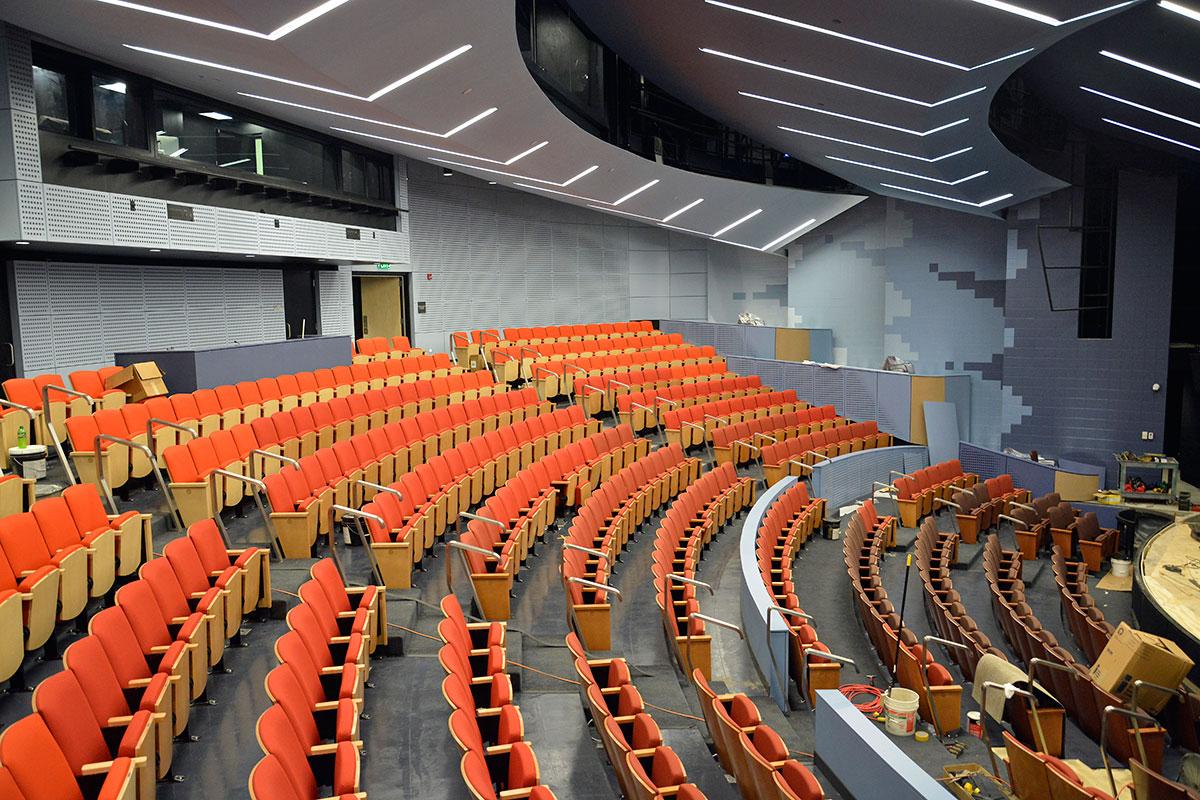Curtain rising—Waterman Theatre will display its improved sightlines, more accessible seating, new sound and lighting and rigging systems and much more this fall as public spaces in Tyler Hall reopen following two years of renovation, revitalization and modernization of the college’s arts building.
A new era in the fine and performing arts at the college will begin unfolding Monday when students enter the new main entrances of Tyler Hall to find bright, modern, flexible, accessible and technologically sophisticated spaces, from the lobby to Waterman Theatre, from Tyler Art Gallery to the digital recording studio.
A two-year, $22.2 million first phase of 48-year-old Tyler Hall’s rejuvenation has produced a sweeping new lobby with a curved-glass theater facade; state-of-the-art performance, rehearsal, recording and gallery spaces; and a running start on the $18 million remainder of the project, already under way through 2018.
“We are very excited,” said Julie Pretzat, dean of the School of Communication, Media and the Arts. “It’s spectacular, almost breathtaking. I’m also excited because it will help us tremendously in recruiting students.”
Pretzat and Mitch Fields, associate vice president for facilities, thanked the students, faculty and staff of art, music and theater—as well as the arts-loving public—for patience and flexibility in dealing with project delays and with moves to temporary facilities and forums. Fields also noted faculty members’ active assistance in the Pfeiffer Architects design.
“I think that from where we were with Tyler to where we are now is thousands of percentage points better,” he said. For example, he said, faculty collaboration with designers in arriving at a color scheme for the main lobby and the theater lobby immediately below resulted in an end product that “relates a lot to the organic Oswego” and that conveys “almost an abstract impressionist painting.”
The lobby gained space from relocation of the former centralized east entrance to two new, accessible corner entrances. New windows and removal of part of a surrounding exterior wall allow in natural light. The long curve of a spindled railing and the theater façade of individually crafted tiles welcome visitors. A new box office, a coatroom and the all-new Tyler Art Gallery also greet the public.
Waterman modernized
Down one level and accessible via a new elevator as well as a completely rebuilt original elevator or a single flight of stairs awaits the reconfigured, renovated and modernized Waterman Theatre, featuring better sight lines, easier access to seats thanks to two new interior aisles, and an induction loop for the hearing impaired. Productions will benefit from digital lighting and sound systems, all new rigging, and a rebuilt stage with a new orchestra pit and traps.
“The new Waterman will enable us to train students in the most up-to-date of theaters,” Pretzat said.
A makeover for the art gallery will boast what Fields calls “a more kinetic, adaptable space,” featuring a pivoting entrance wall, windows that can be covered to increase exhibition space, upgraded lighting and multimedia equipment, and even an adjacent kitchen to facilitate artist receptions.
Music unveils a new choral rehearsal room featuring rolling hideaway shelves for sheet music and what promises to be superior acoustics, Fields said, while a dramatic and glassy two-story instrumental rehearsal hall will provide a new signature performance space. Student practice rooms all received upgrades. State-of-the-art equipment graces the new recording studios for live audio and for digital recording.
“This is still a work in progress,” Pretzat said. “Some faculty remain in temporary offices and some classes remain in Hewitt.”
Next phases
The utilities infrastructure of Tyler Hall—including all new mechanicals relocated to the roof, safety features and more—have been dealt with, Fields said, allowing contractors to focus on remaining visible improvements in phases II and III, among them modernization of backstage theater operations such as scenery craft; upgrades for art studios, smart classrooms and remaining offices; and Tyler Hall exterior cleaning and landscaping.
While School of Communication, Media and the Arts faculty and staff anticipate growth in enrollment in the arts due to Tyler’s rebirth, Pretzat said the public can anticipate enhanced arts experiences—and participation. The school in cooperation with the Division of Alumni and Development is in the midst of a naming campaign for each of Waterman Theatre’s more than 400 seats. More than 135 people and groups have already participated.
While the first public events for both Waterman Theatre and Tyler Art Gallery are scheduled to take place earlier this fall, the campus and community will celebrate the new Tyler during a gala week of performances, open houses and other events starting Thursday, Oct. 27.




